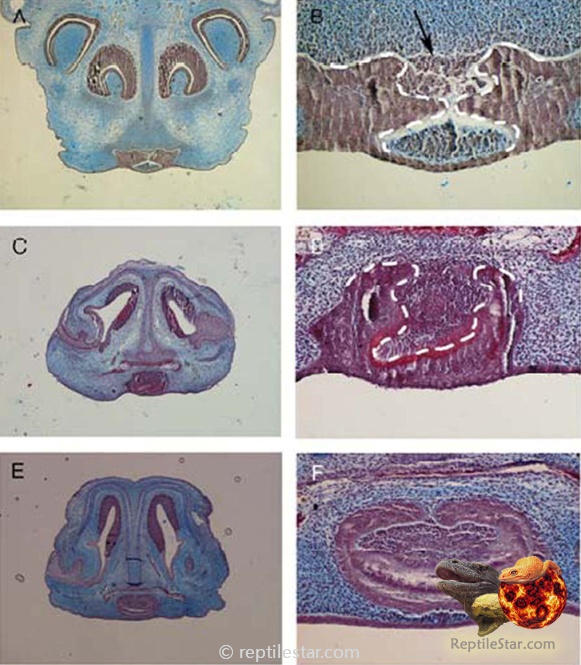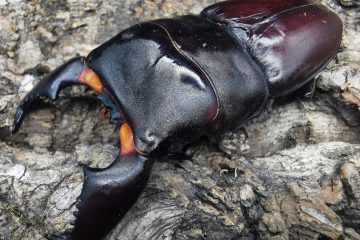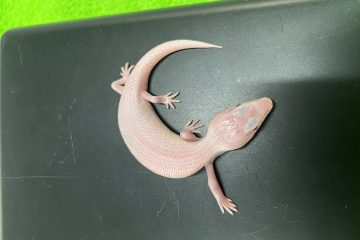Jam在Ratsnakes上翻到的一篇关于蛇类卵齿发育的文章,共享。
暂未翻译!
Authors: H. Bandali, M. Buchtova, J. M. Richman & A. S. Tucker
INTRODUCTION:
The egg tooth is a vital structure allowing hatchlings to escape from the egg. In squamate (scaly) retiles the egg tooth is a real tooth that develops within the oral cavity at the top of the upper jaw. Primitive squamates, such as geckos, have two egg teeth, while more advanced squamates, including snakes, have a single medial egg tooth. We have investigated how the single egg tooth develops using two snakes, the python and corn snake, Elaphe guttata, and investigated the relationship between the egg tooth and neighboring premaxillary teeth.
METHODS:
Frontal and sagittal wax sections were made through the upper and lower jaw at a variety of embryonic ages. Slides were stained for histology or TUNEL staining. Snake Shh was cloned in the corn snake and African rock python, Python sebae, and in situ hybridisation carried out.
RESULTS:
In the python and corn snake two closely positioned tooth germs are present in the midline of the upper jaw at early stages and these grow together and fuse during development to form a single large egg tooth associated with the premaxilla. The egg tooth is precocious in its development and much larger than the rest of the dentition. Teeth on the dentary (lower jaw) and maxilla, pterygoid and palantine
(two tooth rows of upper jaw) develop deep within the jaw from an extended dental lamina1. In contrast, the egg tooth develops near to the oral surface. This superficial mode of development is also observed for the premaxillary teeth in the python. These teeth lie on either side of the egg tooth and share a shallow dental lamina. Unlike the python, the corn snake has no premaxillary teeth. In the embryo, however, it is clear that the premaxilllary tooth germs form and start to produce dentine but then regress during later stages of development. This regression appears not to involve apoptosis (programmed cell death), as is associated with the loss of vestigal tooth germs in the mouse diastema region.

The egg tooth in the snake forms by a fusion of two closely positioned tooth germs. This is in contrast to the situation observed in many lizards where two toothgerms initially form, but then one regresses, while the other moves into a central location2. The single egg tooth of a lizard, such as Lacerta, and that of a snake, therefore forms by a very different process.
Fusion of midline teeth in the upper jaw is also observed in humans with SMMCI syndrome. This syndrome has been related to a disruption in Shh signalling in the midline3. A reduction in Shh signalling may therefore have lead to the fusion of the egg tooth primordial during the evolution of the snakes. The close association of the egg tooth with the premaxillary dentition, implies that the egg tooth is not
a novel structure but an adaptation of the premaxillary dentition.
REFERENCES:
1 M. Buctova, J.C. Boughner, K.Fu., V.M.Diewert, J.M.Richman (2007) Zoology 110:231-251.
2 G.R. De Beer (1949) Proc. Linn Soc Lon. 161:218-224.
3 L.Nanni, J.E.Ming, Y.Du, R.K.Hall, M.Aldred,A.Bankier, M.Muenke (2001) Am. J. Med.Genetics 102:1-10.
ACKNOWLEDGEMENTS:
Python embryos were provided by Marty Cohn and the Rainforest Reptile refuge in British Columbia. JMR is funded by NSERC and AST is funded by the MRC and is a member of COST action B23, working group WG1.
European Cells and Materials Vol. 14. Suppl. 2, 2007 (page 134) ISSN 1473-2262
Published with permission from the author Abigail Tucker
Author: H. Bandali et al.


